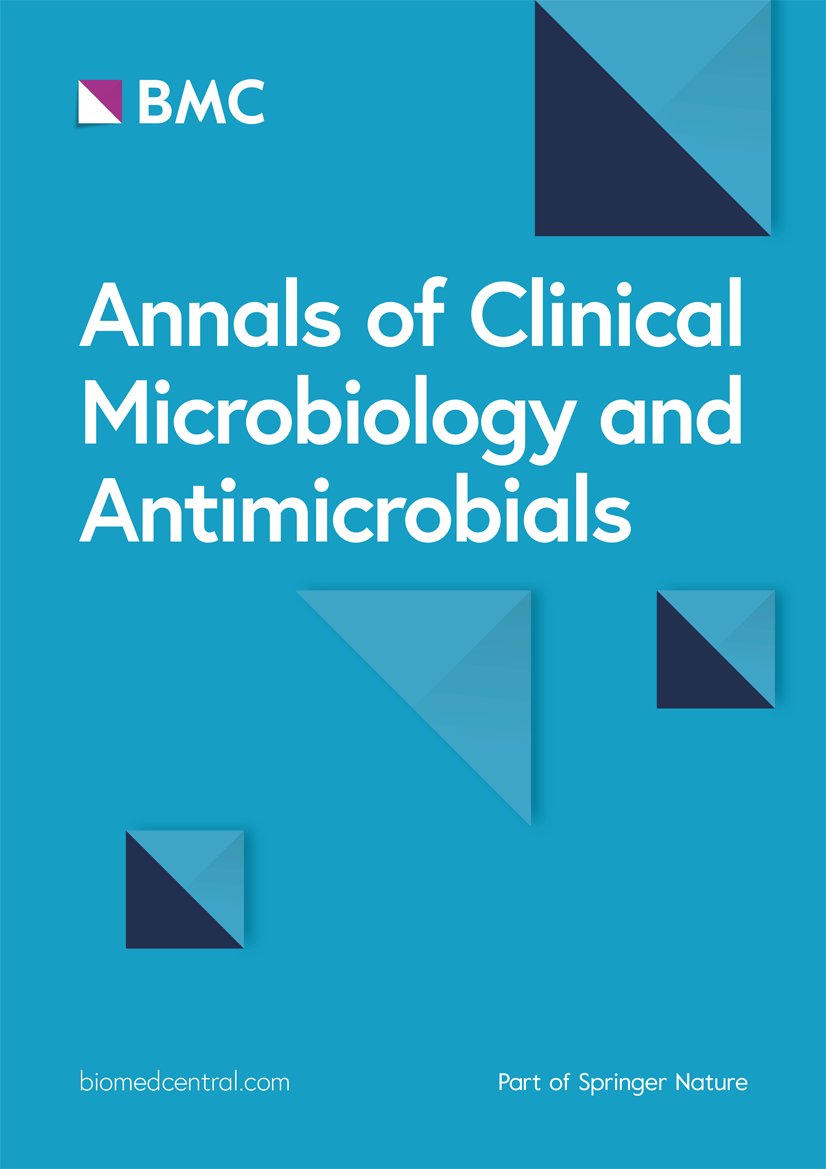伊朗产β-内酰胺酶铜绿假单胞菌的基因组多样性;全球高风险克隆的影响
IF 4.6
2区 医学
Q1 MICROBIOLOGY
Annals of Clinical Microbiology and Antimicrobials
Pub Date : 2024-01-13
DOI:10.1186/s12941-024-00668-5
引用次数: 0
摘要
耐多药铜绿假单胞菌引起的医院感染会延长住院时间,增加治疗费用,导致死亡率上升。我们对临床样本中产生碳青霉烯酶的铜绿假单胞菌高危克隆的频率进行了调查。在这项横断面研究中,从伊朗不同的医疗中心分离出 155 株非重复性铜绿假单胞菌。通过表型和基因型方法确定了对抗生素的敏感性,并检测了β-内酰胺酶的存在。对所有分离菌株的克隆关系进行了调查,并使用多焦点序列分型(MLST)来确定碳青霉烯酶生产者的序列类型。结果显示,对可乐定的敏感率最高(94.9%)。MOX和FOX的敏感率均低至1.95%(3/155)。最常见的窄谱β-内酰胺酶是 SHV,频率为 7.7%(12/155),其次是 PER、OXA-1 和 TEM,频率分别为 7.1%(11/155)、3.2%(5/155)和 1.3%(2/155)。在 28 个分离株(18%)中检测到碳青霉烯酶。最常见的碳青霉烯酶是 IMP,占 9%(14/155),其次是 NDM,占 8.4%(13/155)。在一个分离物中还检测到了 OXA-48 和 VIM(0.65%)。对碳青霉烯类耐药铜绿假单胞菌分离物的 MLST 显示,ST244、ST664、ST235 和 ST357 在受试临床环境中广泛传播。REP-PCR 在我们的临床环境中发现了高度的基因组多样性。ST235 菌株的克隆增殖在铜绿假单胞菌 MDR 模式的传播中起到了关键作用。我们的数据表明,高风险克隆已在伊朗分布,因此需要制定计划来限制这些克隆的传播。本文章由计算机程序翻译,如有差异,请以英文原文为准。
Genomic diversity of β-lactamase producing Pseudomonas aeruginosa in Iran; the impact of global high-risk clones
Hospital-acquired infections caused by multidrug-resistant Pseudomonas aeruginosa incline hospital stay and costs of treatment that resulted in an increased mortality rate. The frequency of P. aeruginosa high-risk clones producing carbapenemases was investigated in our clinical samples. In this cross-sectional study, 155 non-repetitive P. aeruginosa isolates were included from different medical centers of Iran. Antibiotic susceptibility testing was determined, and the presence of β-lactamases were sought by phenotypic and genotypic methods. The clonal relationship of all isolates was investigated, and multi-locus sequence typing (MLST) was used for finding the sequence types of carbapenemase-producers. The agent with highest percent susceptibility rate was recorded for colistin (94.9%). MOX and FOX were found both as low as 1.95% (3/155). The most frequent narrow spectrum β-lactamase was SHV with 7.7% (12/155) followed by PER, OXA-1, and TEM with the frequency of 7.1% (11/155), 3.2% (5/155), and 1.3% (2/155), respectively. Carbapenemases were detected in 28 isolates (18%). The most frequent carbapenemase was IMP with 9% (14/155) followed by NDM, 8.4% (13/155). OXA-48 and VIM were also detected both per one isolate (0.65%). MLST of carbapenem resistant P. aeruginosa isolates revealed that ST244, ST664, ST235, and ST357 were spread in subjected clinical settings. REP-PCR uncovered high genomic diversity in our clinical setting. Clonal proliferation of ST235 strain plays a key role in the propagation of MDR pattern in P. aeruginosa. Our data showed that high-risk clones has distributed in Iran, and programs are required to limit spreading of these clones.
求助全文
通过发布文献求助,成功后即可免费获取论文全文。
去求助
来源期刊

Annals of Clinical Microbiology and Antimicrobials
MICROBIOLOGY-
CiteScore
8.60
自引率
0.00%
发文量
49
审稿时长
>12 weeks
期刊介绍:
Annals of Clinical Microbiology and Antimicrobials considers good quality, novel and international research of more than regional relevance. Research must include epidemiological and/or clinical information about isolates, and the journal covers the clinical microbiology of bacteria, viruses and fungi, as well as antimicrobial treatment of infectious diseases.
Annals of Clinical Microbiology and Antimicrobials is an open access, peer-reviewed journal focusing on information concerning clinical microbiology, infectious diseases and antimicrobials. The management of infectious disease is dependent on correct diagnosis and appropriate antimicrobial treatment, and with this in mind, the journal aims to improve the communication between laboratory and clinical science in the field of clinical microbiology and antimicrobial treatment. Furthermore, the journal has no restrictions on space or access; this ensures that the journal can reach the widest possible audience.
 求助内容:
求助内容: 应助结果提醒方式:
应助结果提醒方式:


